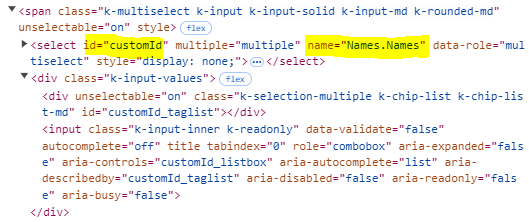### Bug report
When using the @Html.EditorFor(m => m) configuration to initialize a MultiSelect TagHelper editor, and passing a specified value for its "id" attribute, the "name" attribute of the <select> element contains a prefix.
### Reproduction of the problem
1. Set the MultiSelect TagHelper as an editor editor of a specified Model property and set the "id" attribute using ViewData:
//Model
[UIHint("CustomMultiSelect")]
public IEnumerable<string> Names { get; set; }
//~.Views/Shared/EditorTemplates/CustomMultiSelect.cshtml
@model IEnumerable<string>
@{
var id = ViewData["id"]?.ToString();
}
<kendo-multiselect for="@Model" placeholder="some custom behavior" bind-to='ViewData["Data"] as List<string>' id='@id'></kendo-multiselect>2. Define @Html.EditorFor(a=>a.Names, new{id="customId"}) in a form:
@model MyModel
<form id="myForm" data-method="POST" asp-action="Save" asp-controller="Home" class="k-form k-form-md">
<div class="k-form-layout k-d-grid">
<div class="k-form-field">
@Html.EditorFor(a=>a.Names, new{id="customId"})
</div>
</div>
...
</form>3. When the MultiSelect is loaded, its "name" attribute is "Names.Names" rather than "Names":
When using the HtmlHelper version of the MultiSelect, the "name" attribute is correct:
//~.Views/Shared/EditorTemplates/CustomMultiSelect.cshtml
@model IEnumerable<string>
@{
var id = ViewData["id"]?.ToString();
}
@(Html.Kendo().MultiSelectFor(m => m)
.Placeholder("some custom behavior")
.BindTo((List<string>)ViewData["Data"])
.HtmlAttributes(new { id = @id })
)### Expected/desired behavior
When using the @Html.EditorFor(m => m) configuration, the "name" attribute of the MultiSelect TagHelper must match the Model property name when the "id" attribute is set to a custom value.
### Environment
* **Telerik UI for ASP.NET Core version: 2024.3.806
* **Browser: [all]

